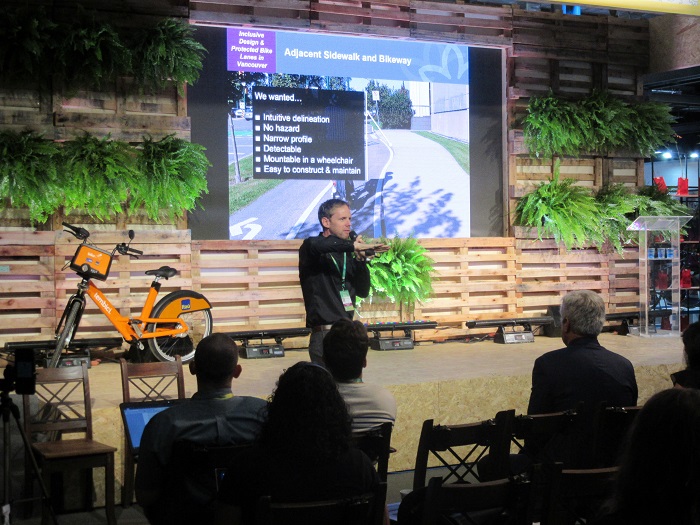
Velo-city day 4: Copy & Paste Infrastructure
Participants of the “Copy & Paste Infrastructure” session discussed challenges and adaptations of applying the Dutch or Danish cycling infrastructure design standards and solutions to other countries, and analysed cases of success and failure.
“There are certain key design principles to cycle infrastructure, that can and should be adapted everywhere” – started Aleksander Buczyński, ECF Infrastructure Officer – “for example, cyclists need curves, not straight angles, to change direction, and they must lean into the curve, so they need extra space on the inside”. But things get more complicated when it comes to copying and pasting solutions that depend e.g. on efficient enforcement of traffic rules or volumes of cycle traffic. There are also a few still “uncharted” areas that are not yet covered by established cycling design standards.
Dylan Passmore, Senior Transportation Design Engineer with the City of Vancouver explained some of the challenges Vancouver wrestles with in “copying and pasting” designs for protected bike lanes and protected intersections with respect to people with vision impairment. He proposed several improvements in universal design practices to create more inclusive infrastructure. For example, after testing several different measures for delineating the sidewalk and adjacent cycle path, a 50 mm bevelled curb with a 3:1 incline got the most positive feedback from cyclists, pedestrians, vision-impaired pedestrians, and wheelchair users. Dylan concluded that it is important to improve pedestrian – cyclists interactions, but we also need to keep priorities in perspective, cars are still the main source of danger: “Only 1% of the interactions observed between cyclists and pedestrians at the test site were assessed to involve ‘major discomfort’ and none involved a collision. At the same time, at a pair of adjacent intersections that most pedestrians at the test site would have had to walk through, there has been an average of 60 collisions annually in which someone was injured.”
Warner Wonk from iFluxo (Brazil) relayed his experience as a Dutch engineer in implementing cycling projects in Rio de Janeiro. He introduced new dimension to the discussion: asking “how much we can copy and paste” not only in relation to strictly technical solutions, but also to the process of development of cycle infrastructure. Copy and paste bicycle infrastructure can be used as a quick project start up. Having examples implemented in a local context helps to align people and adjust the final version to local needs.
The last presentation was given by Tim Blumenthal, president of PeopleForBikes (USA). He focused on methodology of evaluation on how bike-friendly American cities are. The methodology includes both statistical and survey indicators, grouped into 5 categories: ridership, safety, network, acceleration (in cycling development), and reach (including e.g. gender balance). He ended with an introduction of Bike Network Analysis, which assesses the degree to which people can comfortably bike to the places they want to go.
In the discussion speakers agreed that it is important to follow copy and paste good practices. There was also an interesting observation that sometimes examples from “follower” cities, like Sevilla or New York, might be more inspiring for municipalities only just starting to develop cycling infrastructure, than from champions like Amsterdam or Copenhagen.
Network/Project Involved:
Contact the author
Recent news!
Upcoming events
Contact Us
Avenue des Arts, 7-8
Postal address: Rue de la Charité, 22
1210 Brussels, Belgium









